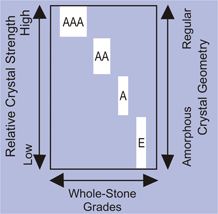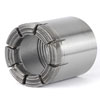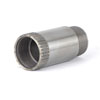- Surface set
Diamond Type - Bit Crown
Profiles - Waterway
Configurations - Diamond
Grades - Diamond Size
Ranges
Surface Set Diamond Type
As the name suggests, the surface-set diamond bit differs from the impregnated diamond type in that they are set with a single layer of natural drill diamond on the working surfaces of the bit crown in a pre-determined pattern.
The diamonds are mounted in a bit crown powdered metal matrix body that is fused to a steel tool body or shank. Unlike impregnated diamond bits where the controlled erosion of the powdered metal bit crown is desirable to expose new diamond crystals, the metal bond matrix used for all IDP surface-set bits is extremely tough and wear-resistant. The function of the bit crown matrix body on a surface-set bit is to securely hold the diamonds in position throughout the operational life of the bit.
Surface-Set diamond bits are primarily recommended for use in drilling relatively soft, abrasive, unconsolidated formations that are not effectively drilled by impregnated diamond bits. They are also recommended for use in drilling harder formations where the available rotational speeds and bit loads are insufficient to use impregnated diamond bits due to drilling equipment limitations.
In most cases, surface-set diamond bits will provide higher rates of penetration than impregnated diamond bits in softer formations due largely to the greater degree of exposure of the individual diamond crystals. However, as they are set with only a single layer of diamond crystals, surface-set diamond bits will generally yield a lower overall bit life than impregnated diamond bits.
Bit Crown Profiles
Bit Crown Profiles for Surface-Set Diamond Core Bits
Most sizes of surface-set diamond core bits manufactured by IDP are offered in several different bit crown profiles, each of which has a specific range of application depending on the drilling conditions encountered. The most commonly used surface-set diamond bit crown profiles used for mineral exploration applications are the ‘Semi-Round’, the ‘Stepped’ and the ‘Pilot’ types. For large diameter, thick kerf surface-set diamond core bits that are used in predominantly soft, unconsolidated and abrasive formations, the Round profiles are most commonly used.
Semi-Round Profile
This is the most common profile for surface-set diamond mineral exploration core bits and is the standard profile for all core bits with kerf widths of 0.39 inch (10 mm) or less. Semi-round profile core bits are cost effective in that they generally have a lower overall total set carat weight than core bits with comparable kerf widths and nominal diamond sizes that use other bit crown profiles. The application range of the semi-round profile is extensive and is suitable for use in soft to hard formations and is particularly well-suited for use in fractured formations.
Stepped Profile
The application of this profile is primarily on medium to wide kerf, Wireline mineral exploration surface-set diamond core bits that are used to drill medium-hard formations. This profile will provide good stabilization where hole deviation is a problem and will usually yield a higher rate of penetration than any other surface-set diamond core bit crown profile. As the nose or “pilot” of this profile is relatively fragile, it is not recommended for use in heavily fractured formations. As the geometry of this profile is not well suited for the setting of large cutting elements, stepped profile surface-set diamond core bits are generally supplied with natural drill diamonds in the 10 SPC to 100 SPC size range.
Pilot Profile
The normal application of this profile is for narrow kerf surface-set diamond core bits that are used to drill medium-hard formations. This profile provides good stabilization where hole deviation is a problem and will usually yield a higher rate of penetration than similar kerf width core bits using the Semi-Round profile. This profile is also recommended where the width of the core bit kerf is too narrow to use the Stepped profile.
Waterway Configurations
Waterway Configurations for Surface-Set Core Bits
With the exception of some thin-kerf surface-set core bits, most sizes are offered in three different waterway configurations. These various waterway configurations have distinct ranges of application and have the function of controlling the bit hydraulics.
Regular Configuration
Unless otherwise specified, this is the standard waterway configuration used on all mineral exploration of surface-set core bits manufactured by IDP. This design uses canal type waterways that are approximately 0.12 inch (3 mm) wide. These waterway canals pass the circulating fluid from inside diameter of the bit crown, across the face and eject the fluid and cuttings at the outside diameter of the bit crown.
The Style ‘W’ waterway configuration is available for all sizes of surface-set diamond core bits produced by IDP.
The IDP code for this waterway configuration style is ‘W’. (Example: A IDP core bit with the descriptor ‘6W’ in its designation would indicate that the bit is supplied with 6 internal discharge canal type waterways).
Other customer specified waterway canal widths are available on request. In addition to the rectangular shaped waterway canals, thick-kerf, large diameter surface-set diamond core bits are often supplied with either trapezoidal or spiral shaped waterway canals to aid in the ejection of cuttings from the bit face. They also commonly include the use of junk slots in their waterway configurations.
Face-Discharge Configuration
This waterway configuration is recommended for use when drilling in relatively soft, unconsolidated formations and/or when using triple-tube wireline core barrel systems. Unlike core bits that are manufactured with conventional canal type waterways that eject the circulating fluid through ports on the inside diameter of the bit crown, the Face-Discharge configuration ejects the fluid through ports molded into the face of the bit. The re-direction of the circulating fluid results in minimum core wash and reduces the potential for subsequent core erosion.
Each waterway element typically has a canal width and flushing port diameter of 0.25 inch (6.3 mm).
The Style ‘FD’ waterway configuration is available on all Wireline core bits as well as on core bits with kerf widths greater than 0.39 inch (10 mm) that are used with conventional (non-Wireline) core barrel systems. The IDP code for this waterway configuration style is ‘FD’. (Example: A IDP core bit with the descriptor ‘6FD’ in its designation would indicate that the bit is supplied with 6 face-discharge type waterways).
Junk Slots
These are large output fluid passages that are molded into the outside diameter of a surface-set diamond bit crown to permit the ejection of large cuttings from the face of the bit. Typically, the addition of junk slots to a surface-set bit crown is restricted to large diameter coring and non-coring bits used in geotechnical and petroleum drilling applications where the formations are relatively soft and abrasive, the bit is set with either large particle size diamonds or PCD elements and the resulting cuttings tend to be long and sheared.
The number of junk slots that may be placed on a bit crown is a function of both its diameter and waterway configuration and must be divisible by the number of input waterways in order to establish a uniform pattern. The preferred number of junk slots is three (equally spaced) in order to preserve the dynamic balance of the bit during operation. Consideration should also be given to the effect of reducing the amount of outside gauge diameter setting resulting from the incorporation of junk slots into the bit crown design.
Diamond Grades
All surface-set diamond bits manufactured by IDP are available with one of eight standard grades of natural drill diamond set on the cutting surfaces of the bit face. The diamond grades are described as follows:
AAA Grade
Premium quality natural drill diamond. These stones are round to octahedral and dodecahedral in shape and may have small amounts of internal inclusions with no cracks or fissures.
AA Grade
High quality natural drill diamond. These stones are mainly round with a small percentage of off-shaped stones and somewhat spotted as well as crystal shaped stones.
A Grade
Medium quality natural drill diamond. These stones have a generally blocky shape with somewhat broken surfaces and sharp edges. Many have fissures, inclusions and minor surface cracks.
Physical Properties of Natural Diamond Grades

Application of Natural Diamond Grades
The general rule for selecting the appropriate diamond grade is that the harder the rock, the better the diamond toughness and crystal geometry should be. For example, the selection of the “AAA” or “AA” grade would be appropriate for use in a hard, consolidated granite formation while the selection of the “P2” or “P3” grade would be appropriate for use in a limestone or sandstone formation.
Kicker Grade
This is a special grade of diamond that is applied exclusively as gauge diameter setting below the bit face on surface-set diamond bits and casing shoes. The inherently low crystal strength of Kicker grade diamond makes it unsuitable for bit face setting but is more than adequate for use in wear protection applications on the set diameters of drill bits where there is little load on the diamonds. Kicker grade diamonds range in shape from angular or elongated to completely amorphous. Their coloring is variable and they frequently possess fissures, cracks and inclusions.
Diamond Size Ranges
The size of the diamonds used in surface-set drill bits are normally described as the number of stones per carat (SPC). The general rule for selecting the appropriate diamond size is that the harder the rock, the smaller the diamond. For example, a hard, relatively non-abrasive granite formation in the 6 to 7Moh’ss hardness range would probably be best drilled with a 100 SPC surface-set diamond bit while a soft, abrasive limestone formation in the 4 Moh’s hardness range might be best drilled by a 10 SPC surface-set diamond bit.
As the diamonds that are used in surface-set bits are naturally occurring, they fall into a broad range of sizes. Each of the SPC sizes that are referred to in describing IDP’s surface-set drill bits are actually nominal values that represent a set range of SPC sizes and are defined in the following table.
| IDP Diamond Size Range (SPC) | Actual number of stones per carat |
| 2/3 | 2 to 3 |
| 4/5 | 4 to 5 |
| 6/8 | 6 to 8 |
| 10 | 9 to 12 |
| 15 | 13 to 20 |
| 25 | 21 to 35 |
| 50 | 36 to 60 |
| 75 | 61 to 90 |
| 100 | 91 to 120 |




